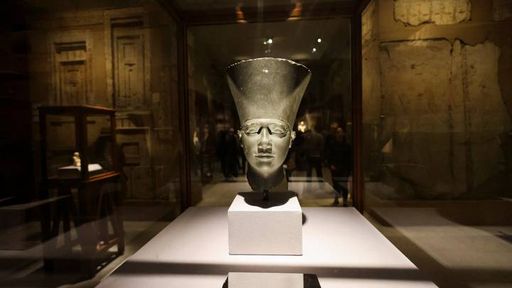In the heart of Aswan, Egypt, a joint Egyptian-Italian archaeological mission is meticulously piecing together the story of a man named Ca-Mesio and his family, whose rock-cut tombs date back centuries ago.
The grave containing hieroglyphic inscriptions is in a good state of preservation, the Egyptian Ministry of Antiquities and Tourism said in a statement.
The discovery was made by a collaborative team from the Egyptian Supreme Council of Antiquities and the University of Milan and sheds new light on funerary practices and social structures in ancient Egypt, the statement added.
The tomb of Ca-Mesio
The mission, working in the ancient cemetery surrounding the Aga Khan Mausoleum on Aswan's West Bank, uncovered several rock-cut tombs adorned with well-preserved hieroglyphic inscriptions.
Among these, researchers found Tomb No. 38 standing out as particularly intriguing. Located more than two meters below ground, it's accessed by a nine-step stone staircase, flanked by mud-brick terraces that once served as platforms for funerary offerings.
At the tomb's core lies a two-meter-tall limestone sarcophagus carved directly into the mountain, featuring a lid sculpted with a human face, a wig, and intricate decorative elements.
Inside the tomb, two columns of hieroglyphic inscriptions offer prayers to local Aswan deities and reveal the name of the tomb's owner, Ca-Mesio, along with mentions of his family members.
The discovery of several mummies, including those of children, deepens the mystery surrounding this ancient family.
Professor Mohamed Abdel Badie, Head of the Egyptian Antiquities Sector, notes that the hilltop plateau in Aswan, where the tomb was found, is home to massive underground tombs from the Ptolemaic era, originally intended for elite families and later reused during the Roman period.

Egyptologists using this context believe Ca-Mesio may have been a high-ranking Egyptian official.
Unlocking secrets
Investigators are eager to determine what befell Ca-Mesio and his family, particularly the children who died young, and they are hoping modern technology can play a crucial role.
Egypt’s Ministry of Antiquities and Tourism says Egyptologists are examining the mummies, with CT scans and biological analyses set to help determine their identities and causes of death.
The use of three-dimensional imaging technology has revolutionised the study of mummies, offering unparalleled insights into ancient civilisations without harming delicate artefacts.
This cutting-edge approach has already yielded remarkable discoveries, such as the meticulous investigation of Egyptian pharaoh Amenhotep I.
These digital "unwrappings" and scans allow researchers to uncover fascinating details of life over two millennia ago, preserving the specimens for future generations of scientists.
Enduring legacy of mummification
The practice of mummification itself is a testament to ancient Egyptian beliefs about the afterlife. The earliest forms of preservation occurred naturally due to Egypt's arid climate, with bodies buried in shallow pit graves being dried out by the desert sand.
This natural phenomenon is believed to have influenced the development of mummification as a deliberate ritual practice, thought to have begun around 3400 BC during the 2nd Dynasty. As Egypt prospered, mummification became increasingly elaborate, especially for those of high social standing.
Egypt’s Minister of Tourism and Antiquities Sherif Fathy said the discovery of Ca-Mesio's tomb and the ongoing analysis of its contents underscore the importance of international scientific collaboration in preserving and understanding our shared cultural heritage.
“This find is a qualitative addition to the Aswan Governorate, highlighting the continued significance of archaeological exploration in revealing the rich tapestry of human history,” said Fathy.
Authorities say information from Ca-Mesio's tomb will be made public once investigations are concluded.



















